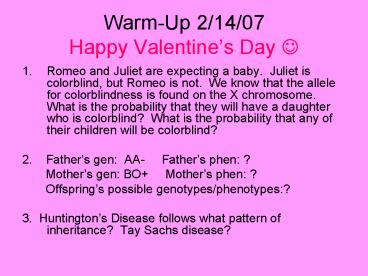WarmUp 21407 Happy Valentines Day - PowerPoint PPT Presentation
1 / 28
Title:
WarmUp 21407 Happy Valentines Day
Description:
Juliet is colorblind, but Romeo is not. We know that the allele for colorblindness is ... Causes DNA to separate (DENATURE) and then come back together (ANNEAL) ... – PowerPoint PPT presentation
Number of Views:36
Avg rating:3.0/5.0
Title: WarmUp 21407 Happy Valentines Day
1
Warm-Up 2/14/07Happy Valentines Day ?
- Romeo and Juliet are expecting a baby. Juliet is
colorblind, but Romeo is not. We know that the
allele for colorblindness is found on the X
chromosome. What is the probability that they
will have a daughter who is colorblind? What is
the probability that any of their children will
be colorblind? - 2. Fathers gen AA- Fathers phen ?
- Mothers gen BO Mothers phen ?
- Offsprings possible genotypes/phenotypes?
- 3. Huntingtons Disease follows what pattern of
inheritance? Tay Sachs disease?
2
DNA/Gene Technology
- Chapter 13
3
Human Genome
- Linkage map
- Location of genes on a chromosome
- Sequencing
- Entire human genome was completed in 2003
- HUMAN GENOME PROJECT
- Applications
- Diagnosis of disorders
- Gene therapy
4
Selective Breeding
- Produces organisms with desired traits
- What are some traits that might be desired by
breeders in these organisms?
5
Inbreeding
- Mating of closely related individuals
- Ensures that offspring remain homozygous for most
traits - Keeps wanted traits in the breed
- Keeps out un-wanted traits
- Does have a high risk of offspring receiving 2
HARMFUL recessive traits - What might this lead to?
6
Hybrids
- Usually produce larger, stronger organisms
- AND VARIATION!
- Mixing dominant recessive keeps out harmful
recessive phenotypes - ESPECIALLY IN PLANTS!
7
Test Cross
- -Used to
- determine
- unknown
- genotypes
8
GENETIC ENGINEERING
- Fast, reliable method for increasing the
frequency of a specific allele in a population - Involves cutting (cleaving) DNA from one organism
inserting into a host organism - Also called recombinant DNA
- RESULS IN
- TRANSGENIC organisms
9
Creating Recombinant DNA
- 1. Cut (cleave) DNA from one organism with a
restriction enzyme - 2. Insert (splice) the wanted genes (DNA) from
another organism (Fig 13.4) - RESULT
- RECOMBINANT DNA TRANSGENIC ORGANISM
- Usually done on plasmid DNA (bacterial)
circular DNA
10
DNA/GENE TECHNOLOGY
- USE
- genetically engineered vaccines
- increasing agricultural yields
- crops which dont need fertilizer
- gene therapy providing what a bad gene didnt
correcting genetic disorders - Use of a virus to infect patient with new gene
11
Clones
12
Possible clone use
- Cloning new stem cells to repair tissues
13
Possible clone use
- Clone successful plants
14
What if there isnt enough DNA in the sample?
- Tiny amounts of DNA can be amplified by a
technique called PCR (polymerase chain reaction)
15
STEP 1 PCRMaking enough DNA to read
- Three step amplification cycle
- Cycles of heating and cooling
- Causes DNA to separate (DENATURE) and then come
back together (ANNEAL) - Generates MORE DNA a certain size of DNA fragment
(from one sample)
16
STEP 2 CUTTING THE DNARestriction Enzyme
- We will use TA-ase, an imaginary enyzme, to cut
our DNA - Sample DNA strand CTGGCTAGGCTACCATGCCCGTAAAT
CTGGCTA GGCTA CCATGCCCGTA AAT
17
STEP 3 SEPARATING THE DNA Gel Electrophoresis
- Electricity separates fragments by size in a gel
- Largest fragment travels least
- Smallest the most
18
(No Transcript)
19
STEP 3 SEPARATING THE DNA Gel Electrophoresis
- CCATGCCCGTA
- CTGGCTA
- GGCTA
- AAT
20
STEP 3 SEPARATING THE DNA Gel
ElectrophoresisRESULTS
- Can be used to ID persons
- Very effective means of
- Criminal identification exclusion
- Paternity cases
- Missing persons
- Entire DNA is not used, only portions known to
differ from individual to individual - Gel is sometimes called an autoradiograph or
autorad
21
STEP 4 READINGHow do you read a DNA
fingerprint?
Victims DNA finger print
22
STEP 4 READINGHow do you read a DNA
fingerprint?
A
B
C
D
E
Victims DNA finger print
Which sample is a match?,
23
STEP 4 READINGHow do you read a DNA
fingerprint?
C
Victims DNA finger print
Which sample is a match?,
24
DNA FINGERPRINTTHE LAB BASICS (A SUMMARY)
- PCR to increase the amount of DNA
- Restriction enzymes to cut the DNA into
different sized fragments - Gel Electrophoresis to separate fragments
according to size - CONCLUSION Try to match fragments from
different samples
25
- I. Crime Scene DNA
- If you are the DNA analyst, you should conclude
that - A. Both Suspects A and B are excluded as the
source of the evidence. - B. Suspect A is excluded as the source of the
evidence, but Suspect B cannot be excluded. - C. Suspect B is excluded as the source of the
evidence, but Suspect A cannot be excluded. - D. Neither Suspect A or B can be excluded as a
source of the evidence. - E. Suspect B cannot be excluded as a source of
the evidence. The results with Suspect A are
inconclusive.
26
Paternity Testing
- Not just matching evidence to suspect
27
(No Transcript)
28
PATERNITY TESTING
- QUESTION
- Which child can be excluded as being the
biological offspring of the father? - He claims NOT to be the father of all these
kids - Child 1 is not his
- Child 2 is not his
- Child 3 is not his
- Child 4 is not his
- NONE of the children can be excluded they ALL
belong to him!































